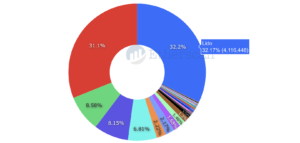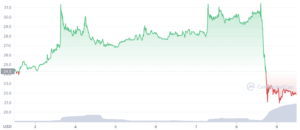Bitcoin is finally moving a little bit, just about crossing $20,000 and currently trading at about that level, while Europe’s STOXX has seen a 3.34% gain.
The dollar strength index is down as well, as is gas, while bond yields fall, all pointing to market wide movements on increasing speculation the Federal Reserve Banks will pivot.
The Reserve Bank of Australia added to those rumors in increasing rates by 0.25%, rather than the 0.5% estimates.
A more than expected slowdown in US manufacturing amid speculation the strong dollar is hurting exports, has also led to re-analyzing what Fed might do.
On the other hand, an expected decision by the OPEC+ cartel to lower supply may raise concerns about inflation.
But, Europe has taken drastic steps to socialize energy costs through government debt. That should bring inflation down by as much as 5% according to some estimates in UK following the package announced by the new Prime Minister Liz Truss.
Such sharp fall in inflation should significantly ease any pressure on central banks to keep hiking, but what gives this Fed pivot speculation most credibility is the fact that things are beginning to break.
Prior to these rumors that Fed will change course, the market has been on edge, with sharks circling in speculative attacks, Credit Suisse being the best example.
The speed of rate hikes, in addition, may raise concerns that the market has not been given time to adjust. British pension funds caught out with their pants down is a clear illustration of the potential dangers.
They were shorting a rise in interest rates, giving them our title of the worst trade of the year certainly, but maybe in history, because even rabbits down the street knew for months that rates were only up and up, with the question only by how much.
The bet of these pension funds has worked however for 15 years when there was no inflation, and so they just kept doing what they were doing even though circumstances changed.
A continuation of rate hikes would then raise the question of just what else is swimming naked. Something that may well provoke market frenzy and a lot worse.
In addition, there have been suggestions Fed’s plan was to pause at this stage in any event. We’d argue the very low month on month inflation for August of 0.1%, and whispers that maybe deflation is returning to Switzerland, may even warrant a 0.25% cut in US interest rates to bring them just below 3%.
However, Fed may worry that if it does that, the market will speculate we’re back to monetary easing. But if they don’t do it this time, and do it next time when inflation will likely be in a clear downwards trajectory, some in the market might speculate that anyway.
The way to keep market expectations in line is to explain your plan precisely, and to not lie to the market by claiming you will be “nimble” to then go on and ignore all data.
That risks a significant communication failure, especially at this point as the market might become completely confused if they hike again.
A pause therefore is in order because measures have been taken to address inflation in regards to energy costs, and therefore general expectations in regards to inflation should be that it will fall, and so Fed won’t need to ‘exaggerate’ to manage expectations.
Fed’s chair Jerome Powell, however, has come across as a bit deaf so far. Some say that’s because he had a plan and he was sticking to that plan no matter what, to get rates to current levels, and now maybe he has ears again.
We probably won’t have a better idea until it is closer to decision time in a few weeks, but for now there’s room to speculate that the macro might be changing.
- Bitcoin
- blockchain
- blockchain compliance
- blockchain conference
- coinbase
- coingenius
- Consensus
- crypto conference
- crypto mining
- cryptocurrency
- decentralized
- DeFi
- Digital Assets
- ethereum
- machine learning
- Markets
- news
- non fungible token
- plato
- plato ai
- Plato Data Intelligence
- Platoblockchain
- PlatoData
- platogaming
- Polygon
- proof of stake
- Third
- Trustnodes
- USA
- W3
- zephyrnet












